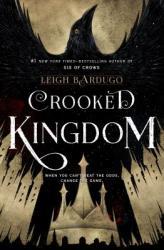
WOW. This was awesome. Spoilers ahead for Six of Crows.
Crooked Kingdom picks up right where Six of Crows left off. Kaz and crew have just been pulled off the heist of a lifetime and then were subsequently stiffed 30 million kruge. Van Eck, the double crosser, stole not only their money, but their comrade/crew member Inej as well. Needless to say, the crew is mad and ready for revenge. The question is...just how far are they willing to go to bring down Van Eck and his cronies?
The answer: pretty far. And it is fantastic.
Bardugo hits all of the right beats in this novel. The heisty stuff is twisty and surprising. The intensity level is insanely high for the duration of the novel. The emotional beats are EMOTIONAL. Like in Six of Crows, each chapter is told from a different character's perspective, and Bardugo uses this technique to develop a rich backstory for each character. I found myself vacillating between loving the characters for who they are and wanting to adopt them off the mean streets of Ketterdam to fix them and give them a loving, safe home. They've all been through a lot, and it informs their lives and choices in a believable way. The villains are semi-developed as the book progresses, and Van Eck at one point does something so terrible that I just sat there and thought WHAT? NO. for like 10 minutes. Bardugo also does a really great job of introducing the very real horrors of human trafficking into a fantasy novel. I hope the book raises some awareness about this very real, terrible issue.
Oh, and a fun bonus: If you've read Bardugo's other series, there are a couple of exciting cameos in store.
Anyway, for me, this was a practically perfect fantasy novel. It made me laugh, cry, and will be something that I'll come back to and re-read every few years. If I could give it more than 5 stars, I would.

Lily is a hopeful songwriter who is struggling in chemistry. After her teacher bans her from having her notebook in class, she writes on the desk instead. This sparks an ongoing conversation through notes with an unknown pen pal. As the letters continue, more and more personal information is shared, and more feelings surface inspiring Lily to write lyrics. With a typical cast of characters – the best friend, the mean girls and boys, the crush(es) – P.S. I Like You isn’t anything too different from many of the other cute, light romances, but it’s still a quick, enjoyable read.
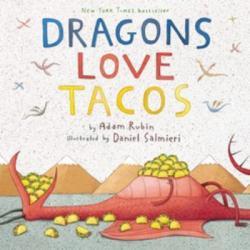
This story has it all, from tacos, to laugh out loud humor, to dragons, to colorful illustrations, and most importantly you also learn about why NEVER to give dragons totally mild salsa with jalapenos. The results are action packed, disastrous, and hilarious. Luckily, the dragons make everything right in the end.
This book is just plain old fashioned silly, and even a bit absurd, fun! The pictures in this book really capture the tone and elevate and enhance the story rather than get in the way. I'd even argue that they might be the main draw of this already entertaining book. The illustrator, Daniel Salmieri, didn't take the illustrations too seriously and you can tell they had as much fun making the book as you will reading it. Enjoy this lighthearted, humorous romp and feel free to enjoy a few tacos along the way when reading!
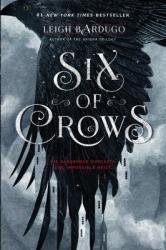
In the city of Ketterdam (imagine an alternate Amsterdam), Kaz is the first lieutenant of one of Ketterdam's most notorious and successful gangs. He's is approached by a city government official with an impossible task - rescue a scientist from the world's most well protected prison. And the prize? 30 million kruge. Kaz, of course, accepts. And he assembles a team of six to pull off what amounts to the world's most ambitious heist.
The story alternates between the POV of five of the six team members, and each character's story is gripping. All characters are developed throughout the course of the books, and each has their own distinct, fascinating voice and story. There's a sharpshooter, a magician, a traitorous solider, a demolitions expert, a wraith (read and find out!) and of course, the fearless leader, Kaz. And, to make things even better, they are a diverse group of people hailing from all over the world.
This book was really fun, and I've never really read anything quite like it. I will be booktalking this one and forcefully shoving it into the hands of anyone who comes into the teen center (I kid. I'll lovingly hand it to them while gushing effusively.). 5 stars
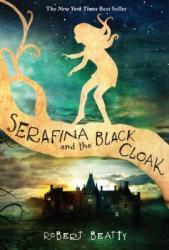
Serafina is the Chief Rat Catcher at Biltmore Estate in Asheville, NC in 1899. She and her Pa secretly live in the basement, where he is basically the electrical engineer of the place. Serafina's presence in the house is a secret so she mostly traverses the estate through tunnels and doesn't go outside. One night, she witnesses a man in a black coat magically abducting a child, which changes everything.
I listened to this book, and the narrator didn't really do it any favors. Her Southern accent was pretty terrible, but thankfully, she kept forgetting to use it. Narration aside though, this book had some problems. The author took a cool premise and an even cooler setting and then wrote a really boring book. There were kind of two main things going on that should have been really interesting, but weren't. The first thing was the identity of the man in the black coat, which was painfully obvious from the start. Had Beatty done a kiddo type version of an Agatha Christie novel (these are the people at the Biltmore estate...and one of them is guilty of MURDER MOST FOUL), I'd probably be typing a really different review right now. Alternatively, he could've played up Serafina's secret a bit more, and that might have made things more interesting. As it was, even though there was a lot going on, nothing of importance ever seemed to really happen.
I also found myself getting annoyed by a fictional Vanderbilt named Braedan (weird name for a kid of Dutch origins in 1899, dontcha think?) who is a bit of a love interest. Every part featuring him was pretty painful as Serafina basically becomes a useless quivering mess when he's around. Blegh. Oh, and at one point, a character says something along the lines of "you don't call girls heroes, you call them heroines" which, just, are you trying to say that girls can't be heroes? Because if so, gross. I'm paraphrasing, but that's what I took away from the statement.
But on the other hand... look at that cover! Gorgeous.
If 1.5 stars was an option, that's what we'd be doing here. I liked the beginning, the premise and the setting, but wish the author had done more with the latter two elements.
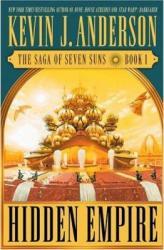
Hidden Empire is the start to the "Saga of the Seven Suns" series by Kevin J. Anderson, an author of dozens of Bestselling and award-winning sci-fi books. If you haven't heard of Kevin J. Anderson, it's probably because a great deal of his writing is done for other pre-existing franchise licenses (Star Wars, Dune, movie novelizations, etc...) where the author’s name tends to less noticed. Having had no previous familiarity with the author myself, I took a gamble on this one when I passed by his publisher’s booth at Denver Comic Con, and had a bit of money still burning in my pocket. I've been pleasantly surprised and now that I’m 3 books in, I think the series is holding up fantastically.
Hidden Empire tells the story of human ingenuity turned reckless by greed. When the Terran Hanseatic League ignites a gas giant into the first man-made star, they awaken a slumbering threat, and inadvertently start a war that threatens to destroy all of human civilization. The enemy is ruthless and unimaginably powerful, and worse yet, the various factions of humanity are divided by their own conflicts and prejudices.
Saga of the Seven Suns is a classic space opera of galactic proportions with a close focus on its characters. It skips the focus on justifying realistic technology that is common in "hard" sci-fi, and though the plot revolves around a war, it is not "military" sci-fi either, in that it's less about space marines and more about xeno-archaeologists and politicians. This is a people-centric story all the way, with the spotlight on the struggles of the individual characters as they each try to navigate the webs of intrigue, conflicting cultural values, and ancient secrets that surround them. Think the grand scale of Star Wars mixed with the plot style of Game of Thrones, featuring a varied cast of Point-of-View characters whose stories conflict, intersect, and illustrate the plot from different perspectives.
Speaking of Game of Thrones, did I mention that this 7 book series has already been completed and fully published? You get all the thrill of binge-reading a sweeping saga that will keep you entertained for months, without have to wait around for 5 years for the resolution to that torturous cliffhanger! There's also a handy glossary at the back of the book to help you keep track of the different people involved in this intricate story.
Note: This book is not to be confused with Hidden Empire by Orson Scott Card. While Card's name is likely more recognizable, Anderson's book was published 2 years prior.
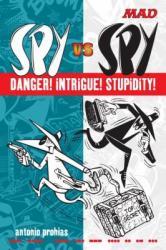
This is a republished work from The All New Mad Secret File On Spy vs Spy. Prohias' compendium of the popular comic strip Spy vs Spy, which appears in MAD Magazine, does not disappoint the Spy vs Spy fandom. Done with great detail and care, each story takes an unexpected turn and you never REALLY know which of the two spies, black or white, will actually be the victor of that particular strip. They all end creatively, typically humorously, and you'll never know how the story will develop.
Prohias is originally a refugee from Cuba and after receiving death threats from Fidel Castro moved to the USA. While it's easy to be caught up in the simplicity of this wordless story, it also is an allegory for the struggle and fruitlessness of the Cold War in the opinion of the author. I love both its simplicity and complexity contained within just a few drawings. Both those who are looking for an easy laugh and those looking for more than that should be satisfied by this collection.
The panels have been blown up so you can really soak in all the detail and hard work Prohias has put into each strip. This can either be interpreted as a good or bad thing. Individuals who are familiar with the strip might enjoy it more since you can really see all the details and take your time examining each panel, taking in all the details that MAD Magazine is famous for. That said, since each page takes up a whole panel what originally took up an eighth of a page can now last five or six full pages of the book. I could see how this could be frustrating for those who are used to graphic novels/comics that are jammed packed. Again, the beauty is in the seeming simplicity of this strip with the underlying complexity, whether it be the story or the art itself. I'd recommend fully for those who are familiar with the strip, while, if you are a Spy vs Spy novice, I might suggest something a bit denser to get a better feel for the comic. Four Stars.
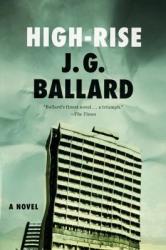
High-Rise (1975) begins with one of the most memorable first lines I’ve ever read, "Later, as he sat on his balcony eating the dog, Dr. Robert Laing reflected on the unusual events that had taken place within this huge apartment building during the previous three months". Laing is a new tenant in a futuristic high rise apartment building on the outskirts of London. The high rise is a microcosm containing restaurants, playgrounds, a swimming pool, and even its own supermarket. There is social order: the wealthiest tenants occupy the building's upper floors with the best views, while the middle-class tenants reside in the lower half of the building, constantly at the mercy of falling champagne bottles from the upper floors. Before long, tensions arise between the tenants of the upper and lower floors. Alternating between Laing and another tenant, Richard Wilder, we witness first-hand the deterioration of ethics and social order within the high rise. Elevators are commandeered, rooms are barricaded, alliances are formed, and blood is shed. Little by little, the layers of human behavior are peeled back, exposing a terrifyingly animalistic core at the heart of the high rise tenants.

Popular mythology author Rick Riordan strikes again! He has series delving into Greek, Roman, Egyptian, and now NORSE mythology. This series follows Magnus Chase, son of a Norse god. Which god, you ask? Read the book and find out!
Riordan’s writing style is very distinct, playing to his youthful audience. The chapter titles were humorous and made no sense until I reached those parts of the book. (I read through them initially and thought, “What the…?!”)
Magnus Chase was vaguely--well, maybe more like strongly--reminiscent of Percy Jackson for me. Although Magnus has had a much rougher life so far, his voice is very similar to that of Percy. Magnus Chase is barely 16 years old, but he has been living on the streets for the past 2 years since his mother’s death. After an...interesting encounter with a fire giant, he finds himself gracing the halls of Valhalla with other Norse warriors killed in battle. Along with his valkyrie, a dwarf, and an elf, he goes on a quest to retrieve the Sword of Summer and stop the wolf Fenrir from escaping his bindings.
A interesting read for those die-hard Riordan fans or anyone who loves mythology interpretations. I was very entertained by the story, as I always am with Riordan’s mythologies, but despite the gods changing, the stories are starting to run together. The overlap of stories definitely doesn’t help the blurring of the lines. (Oh, hi Annabeth!) Crossing over from the Percy Jackson series, Annabeth, last name Chase--I guess we could have seen this one coming--has a couple nice little cameos in this book, foreshadowing a larger role later in the series. I’ll be interested to see where this goes.
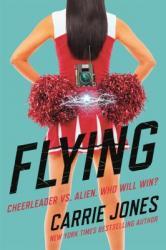
Mana is going along in her perfectly normal life as a high school teenager with two best friends, one of whom is a boy and crush interest. All of a sudden a guy (codename China) taking out an alien, who happens to be hiding out as a cute boy at her school, interrupts a basketball game, and Mana’s world drastically changes. She finds out her mom is also an alien hunter and has disappeared, presumably kidnapped by aliens because of a chip with information she has. To top it off, Mana starts having some weird abilities, like being able to jump really high and do crazy gymnastic stunts. The rest of the book has Mana, her friends, and China on a mission to find Mana’s mom and save the world.
I really liked Carrie Jones’s series, Need. This was definitely a different kind of book. It was lighthearted and, at times, a bit silly, but overall, still a nice, light, fun read.
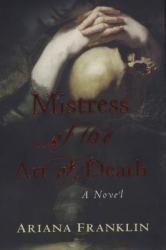
Set in medieval England, Adelia, a female surgeon, is hired by King Henry II as a forensic expert to investigate a series of murders taking place Cambridge. Even though it is a fictional novel, Franklin adds lots of historical details to the story, creating multiple layers to the plot. The murders are not the only mystery in this story, the characters themselves have their own veil of intrigue making the story all the more exciting!
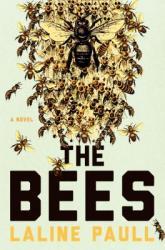
My first thought when this book was recommended to me was, “Bees? Is that metaphor? What do the bees stand for?” NOPE. This book is literally about bees. But not in a nonfiction, documentary kind of way. Here we have a novel in which we discover the world of bees personified.
Enter our main character, Flora 717. She was born the lowest of the low: the sanitation worker bee. Ugly, underappreciated, but unlike her fellow floras, she can speak. One of the higher levels of bees, a priestess to the queen, immediately takes notice of her oddities and experiments with her in roles not typical to a flora.
Flora 717 finds herself in almost every aspect of bee life at some point of her journey through the hive, uncovering secrets as she learns, grows, experiences the most profound loss, and transcends to the highest joys. The ordinary life of these black and yellow creatures we see and often fear is re-imagined into a relatable tale that pierces the veil between bees and humans. Though humans play very little role in the book, the bees exhibit many characteristics of humanity.
The tone of this book can be a bit dark at times with graphic imagery, but I highly recommend it.
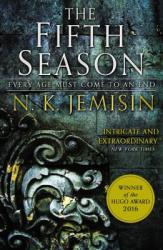
I loved this book. I've been looking for a new fantasy series for a long time now, but I haven't come across anything recently that's caught my eye. I almost gave up on The Fifth Season too, in part because the narration is in second person, which I found jarring at first, and in part because Jemisin drops you in the middle of the action with little explanation and no hand-holding. It took me a few chapters to get into the story and figure out what was going on, but I'm glad I stuck it out because the plot and characters ended up being great. Despite what I just said, I think it's almost better to go into this blind, but I'll try to describe it without giving too much away.
The continent our characters live on, "The Stillness," is a post-apocalyptic hellscape. There is near-constant seismic activity that triggers a new catastrophe (called a "Fifth Season") every few centuries -- sometimes in the form of massive crop-failures, sometimes in the form of volcanic eruptions, sometimes massive earthquakes that destroy whole regions (she includes a helpful appendix of these disasters if you're curious). In this world, there is a group of people known as orogenes (or more derogatorily as "roggas") who have some degree of control over seismic activity -- they can "sess" earthquakes, and, with training, prevent them from being too destructive. But they're also powerful, extremely dangerous, and widely despised -- many people kill their own children when they discover what they are, and it's often a race against time to see if a Guardian (their mysterious and sinister keepers) can arrive to collect the child before the family or the community has killed them. The plot isn't chronological; it moves around from chapter to chapter in order to tell three stories at three points in time: 20-odd years ago, when a young girl is taken to the capital to be trained as an orogene; some 10 years after that when a mid-level orogene goes off on a mission with her senior to investigate a disturbance in a coastal community; and "now," in the immediate aftermath of the latest apocalypse, when we follow a woman who is struggling to cope with her son's murder just as the quake hits.
I'm not going to say that it's an entirely original idea, but I think the execution was solid and I loved the dialogue and cast of characters. There's no lack of action, but Jemisin also takes the time to dig into her characters' emotional lives, and after a while the use of "you" starts to fade into the background. There's a strong focus on discrimination, both in terms of how orogenes are viewed in society and in terms of the treatment of subordinate nations and peoples by the Sanzed Empire that has conquered the continent. A lot of fantasy is set in pseudo-Europe (and often just pseudo-England), so it was refreshing to read something more diverse, and there's a wide variety of representation in terms of race, gender, and sexuality throughout. I would give this 4.5/5 stars if that were possible, but since it isn't I've left it at 4. It wasn't perfect, but it was a very strong start to the series, and I look forward to starting the second book, The Obelisk Gate, which just released this September. I would definitely recommend this to fans of fantasy.

Book 5 (Empire of Storms hereafter EoS) picks up right where book 4 left off, and the action quickly ramps up. At the beginning of EoS, most of our heroes are together after the events that unfolded at Rifthold, and, to a lesser extent, Morath. After defeating and destroying the King of Alderan, Aelin travels to Terrasen, and after receiving no help or support from the various Dukes/Earls or whatever, Aelin opts for some different kind of support. The kind of support that comes from pirates. So Aelin and her merry band of heroes (well, some of them are pretty angsty, actually) depart to get support from Aelin's old "friend", the Pirate Lord Rolfe.
I was kind of expecting to not like this book as I seem to only like every other Throne of Glass book (I really like 2 and 4 and didn't care much for 1 and 3), but this entry in the series defied my expectations in a good way. The action is fairly constant, and the characters continue to develop and act in ways consistent with their current development. Things that annoy me about Aelin continue to annoy me - she makes really key decisions without informing or soliciting advice from her much more seasoned travel companions/court, but a reveal at the end made Aelin a more compelling character (although still, girl, COMMUNICATE). The real fun in the books, for me at least, comes from Aelin's surrounding cast of characters. Even though many of them took a back seat to Aelin in this book (Chaol is unheard from) their interactions were delightful to read, and I will never be sorry spending time with my favorite, Manon. Lysandra also gets a time to shine, and Elide starts to come into her own as well. There are some new characters that wouldn't be new to those that read the prequel novellas, so if you have not read those yet, I strongly suggest reading them before you embark on the 700 pages of awesomeness that is EoS.
On the downside, there was a bit too much romance in the book for me. Like, EVERY character doesn't need to pair up. Especially since they are all hetero-normative (even though there is some discussion of characters being bi). Also, the sex scenes were fairly repetitive and at times unintentionally hilarious (a character literally BURSTS INTO FLAME). I mean, there was a ton of:
Claiming of mouths (what does that even mean and ew)
Going over the edge
"Maleness" (I'm not sure about this one either but probably ew)
Heating at one's core (I'm pretty sure your core is your abs, but whatever)
Nipping at necks
Right. So that all happens a lot.
Oh, and consider yourself warned, this book ends on a cliffhanger.
Anyway, overall, EoS was a great entry in the series and a strong fantasy story. I really really really cannot WAIT for the last one. 4 stars.

Broken Monsters is a thriller set in Detroit in which a detective investigates a serial killer who murders people with a nail gun and then attempts to meld their bodies with those of animals -- or at least, that's how it starts out. The chapters rotate between the perspectives of Gabriella Versado, the detective investigating the case; Layla, her teenage daughter (currently embroiled in a plot to lure out and expose pedophiles); Jonno, a journalist who quit his job and moved to Detroit to reinvent himself by reporting on their art scene; TK, a homeless man working to protect his friends and community; and our serial killer, who finds himself infected by a dream that seems to have the power to rewrite reality itself. While it initially seems like a pretty standard thriller, the murders quickly veer off into the realm of the supernatural. The book is a bit uneven as a result, ending up as a mix of magical undertones plus serial killer crime investigation plus family drama that never quite came together for me. The writing wasn't amazing by any means, but it got the job done, and the plot managed to keep me turning pages. Despite having heard some rave reviews from others, I wasn't wowed by it, but if you're a fan of horror/thrillers this is definitely unique.
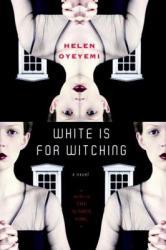
White Is for Witching is a difficult book to describe. I suppose you could say that it's the story of a young woman, Miranda Silver, who suffers from pica, a condition which compels sufferers to crave and eat inedible foods: chalk, plastic, metal, rubber. The story follows her life -- loosely -- from her mother's death when she was a little girl up until her mysterious disappearance in her late teens/early 20s. The story is told from the perspectives of Miranda, her twin brother, her college girlfriend, and the (possibly evil) house/bed & breakfast she lives in, along with a few brief POV sections from side characters. They're nominally piecing together the events that led up to Miranda's disappearance, but that thread often gets lost in the meandering chapters. Fair warning: the plot is difficult to follow and it wasn't until I reread the opening that the story started to click into place. There's a strange, dream-like atmosphere, none of the narrators are anything close to reliable, and it wasn't always clear to me (read: it was almost never clear to me) what was going on. To give a sample of just a few of the plot threads: There are a string of assaults/murders of refugees happening in Dover, England, where Miranda and her family live. Is she connected to them somehow? Some passages seem to suggest so, but we certainly never find out. The house she lives in seems to hate immigrants and may or may not have eaten her female ancestors to keep them from leaving, but don't expect either of these points to be brought to any sort of conclusion. The closest thing to a central thread was the obsession with the possibility that Miranda was or was controlled by a soucouyant, a sort of vampire/shape-shifter in Caribbean traditions. So race, identity, and immigration are obviously big themes, but it's less clear where Oyeyemi is going with everything.
For me, the actual story-line wasn't very satisfying, but the writing style and atmosphere made it worth it. I've read almost everything Oyeyemi has written, and a lot of her stories fall apart at the end; she's great at creating interesting characters/evoking an eerie, ominous mood, but in my opinion resolving a plot is not her strong point. This might be frustrating for some readers, but if you're interested in something a little more experimental and don't mind that it's a bit rough around the edges, you might like this book. I would recommend Oyeyemi's first book, The Icarus Girl, for anyone interested in reading something a little more accessible by her. If this had been the first thing I read by her I might not have picked anything else up, but I enjoyed it for what it was.
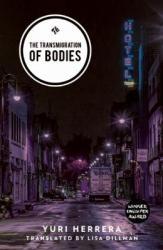
The Redeemer has an unusual profession: he's a "fixer," paid to calm tempers and smooth over the difficult situations that arise in the criminal underworld of the unnamed Mexican city where he lives. Armed only with a gift for talking his way out of difficult situations, he works as a sort of middle man. When our story starts, an outbreak of a new strain of flu has led to a state of emergency. The bodies are piling up, people are panicking, and most of the city is locking themselves up at home to let the illness run its course. The Redeemer would gladly join them, but duty calls. In the middle of all this, two feuding crime families have, through a strange series of coincidences, ended up with the corpses of the other's child (you might be getting some Romeo and Juliet vibes at this point). It's The Redeemer's job to set things right before more violence breaks out.
This book has been out for a while but was just recently translated into English. It's more of a novella -- just 100 pages long -- but I enjoyed the read and felt that it wrapped everything up in a satisfying way. The characters are interesting and well-drawn even in such a short space, and there was a good balance of humor and more sad, reflective moments as we move back and forth between The Redeemer's attempts to seduce his neighbor ("Three Times Blonde") and his investigation of the children's deaths. I would recommend this to lovers of noir, but I think it has a broader appeal as well.
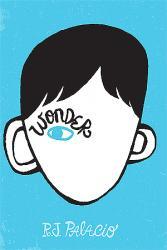
This review contains spoilers.
This is the second time I've read this book. I got more out of it this time. It helped to google Auggie's condition to see what he would have looked like. There were a few chapters about friendship, betrayal, and bullying, that were so powerful I got misty-eyed. I liked that the school ultimately accepted him and loved him. I also liked Via's friend's storyline. Perhaps my favorite part was at the end when he got the award and said that they saw something exceptional, but he just saw himself as a normal kid. But hey, he'd take the award if they wanted to give it to him. :-)
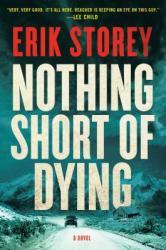
This book has recommendations from heavy hitters like Lee Child and Jeffrey Deaver that make it sound like the greatest thriller they've ever read. I picked it up based on a good review and the Colorado setting, which I usually enjoy. Disappointing all the way around. Generic tough guy antics and prose that fails to capture the feel of Colorado's high country do not add up to the second coming of Elmore Leonard. And this guy's a native, so we can't blame it on the out of state writer doing it by the numbers. For a much better written crime story with a Colorado setting, read The Painter by Peter Heller.
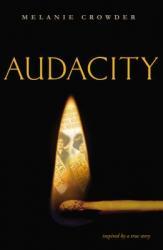
This book is written in prose. This annoyed me for about 20% of the book. Then I got used to it and started enjoying it. It's a powerful true story about a brave woman who stood up for the rights of working women and children. Whenever I read stories about brave women, I ask myself if I would have had the moxie to do what they did. The answer is sometimes yes and sometimes no. This one I'm not sure about. It take real guts to stand up to bullies (in this case sweatshop owners and their thugs). I've never been good at that. She was so determined and stubborn, and she persevered! Amazing.
Bonus: I read this book over Labor Day weekend and didn't realize it until after I had finished.


